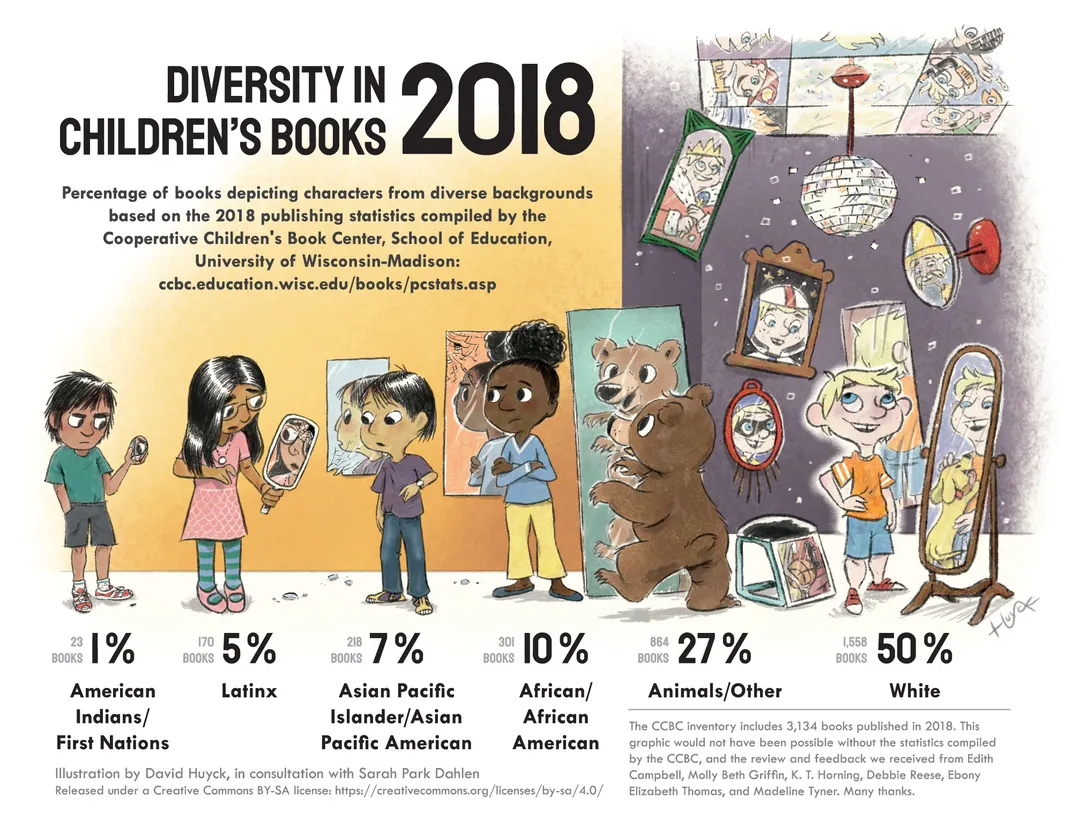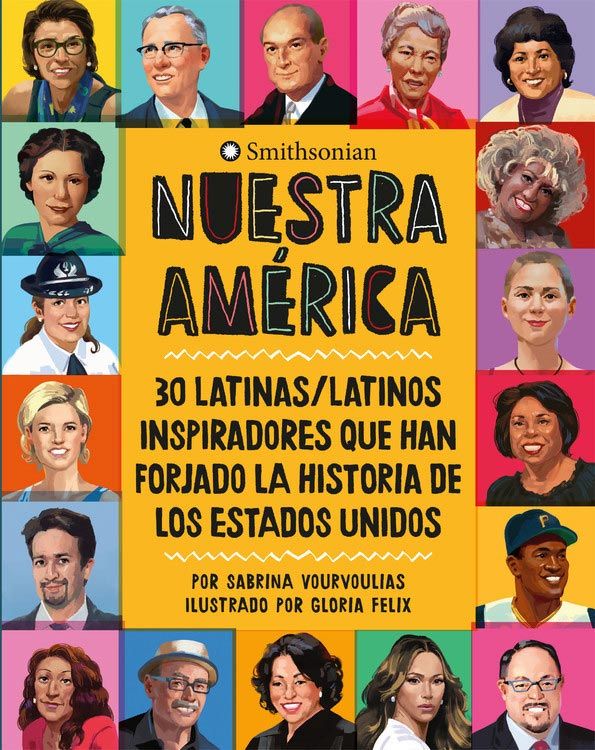NATIONAL MUSEUM OF THE AMERICAN LATINO
Conversations on Nuestra América (Our America)
Introducing a new Latino children’s anthology: “Nuestra América: 30 Inspiring Latinas/Latinos who have Shaped the United States”
/https://tf-cmsv2-smithsonianmag-media.s3.amazonaws.com/blogging/featured/nuestra-america-cover-retail.jpg)
[Versión de este artículo en español disponible aquí.]
Read: Introducing a new Latino children’s anthology, Nuestra América: 30 Inspiring Latinas/Latinos who have Shaped the United States
Did you know that only 5% of children’s literature represents Latinos? Or that less than 1% of this literature showcases Native Americans. And that the highest percentage of diversity in this arena is at a mere 10% for African American Stories? Five percent may sound good, but it translates to only 170 books of all the children’s books published in the U.S. in 2018. Compare this to the U.S. Census Bureau's 2017 statistic that showed that Hispanic students made up 22.7% of all students in the U.S.

Read More
If teachers are to bring diversity and inclusion into the classroom, they need the right resources. We want to encourage parents and caregivers to read with their children. Imagine how powerful it would be if they read stories that resemble their families! It starts with having writers who represent this diversity and publishers that are excited to bring new narratives to readers. It begins with commitment.
The Smithsonian Latino Center is committed to lifelong learning, and that starts with reading. It is why we launched the Molina Family Latino Gallery Childhood and Intergenerational Literacy Initiative, which includes a series of children’s books in partnership with publishers around the nation. Our first publication, Nuestra América: 30 Inspiring Latinas and Latinos who have Shaped the U.S., features profiles and colorful illustrations of activists, public servants, artists, scientists, and more. This book, available in English and Spanish, is needed more than ever to help round out our nation’s history.
Through this process, I have learned that creating an anthology means revisiting the past, knowing that many people will not make it into the final book. The figures included in this book do not represent all the Latinos who have shaped America. However, Nuestra América is a start; the beginning of what we hope is a new era for Latino children’s literature, one that shows all kids that they matter, that they are seen, and that their stories are essential and should be shared. Think about this quote by Martha E. Bernal “I have much to learn and many things left to accomplish”. The stories within the pages of Nuestra América spark our collective and individual curiosity to learn and share.
To Learn more and purchase the book, visit https://latino.si.edu/nuestra-america
Do: Visit the Smithsonian Nuestra América Learning Lab Collection and Explore the Smithsonian Latino Collections, and Participate in the Thinking and Conversation Questions
If the first step in our learning journey is to read and imagine, then the next step is to create and share. The Smithsonian Learning Lab is a portal with photographs, videos, activities, and more. It is here that we have published a collection of learning and teaching resource to accompany the Nuestra América book. The Learning Lab collection contains a series of primary source materials related to select figures found in the book to give readers a better understanding of their contributions. The collection also contains thinking and discussion routines around topics such as what it means to be a public servant or the perspectives that activists share with their community. The collection culminates with an activity that asks students to create an article or online post (social media or blog post) that reflects on one or more of the Latinos profiled in this book, their impact, and its connection to a current event in the news or their community.
Explore our Nuestra América Learning Lab Collection and learn more, dive deep, take your time, and create your own collection.
Analyze: Big Questions, Big Ideas
Naming any book is no small feat. The title needs to encapsulate the content, give a picture of what’s inside, declare its intent, and, ultimately, it must capture the readers interest and imagination. Think about the title and the big questions that it lays at our feet, Nuestra América: 30 Inspiring Latinas and Latinos who have Shaped the U.S. Walk through the title, thinking about the possessive, the intermixing of language, the adjectives, the categories, and the actions. This title is a declaration of the history and the contributions that Latinos have made to the forming and continued growth of this country. There are many to think about this book and its intentions and our hope is that helps kickstart the conversation amongst people about what they will do to inspire and to shape the nation.
In the end, I find myself curious and hopeful. We hope that using this book, the Reading Guide and Discussion Questions, the Learning Lab Collections will help push the conversation forward of what it means to be an individual that helps shape a country, a society, a community. I find myself thinking about inspiration and wonder how we can capture moments that make us sit, ponder, and be in awe of what people can do. This book is more than an anthology of Latino leaders. It is a conversation with the reader about the diversity of our people, backgrounds, dreams, and achievements. For those that want to join me on this journey, I leave you with a few questions to consider, analyze, and discuss with your students and family:
-
What does it mean to be inspirational?
-
Using the examples of the various leaders highlighted in Nuestra América, how do we harness the power of the written word to inspire the dreamers and the leaders?
-
How do we help the next generation shape the future of our country, of Our America and what does that look like?
Conversaciones acerca de Nuestra América
Por Emily Key

Lea: Presentación de una nueva antología latina dedicada a los niños: Nuestra América: 30 latinas/latinos inspiradores que han forjado la historia de los Estados Unidos
¿Sabía usted que las latinos están representados en apenas 5% de la literatura para niños? ¿O que menos de 1% de esta literatura presenta a personajes que sean indígenas americanos? ¿Y que el porcentaje más alto de diversidad en este campo se sitúa en apenas 10% que corresponde a los relatos afroamericanos? Cinco por ciento podría parecer una cifra aceptable, pero ella equivale a apenas 170 libros del total de libros para niños que se publicaron en los Estados Unidos en el 2018. Comparemos esto con los datos del Censo de los Estados Unidos para el 2017 que muestran que 22,7% de todos los estudiantes de los Estados Unidos son de habla hispana.
Para leer más:
Kids Books Still Have A Lack-Of-Diversity Problem, Powerful Image Shows (En los libros para niños todavía hay un problema de falta de diversidad, como lo muestran varias imágenes impactantes)
Number of Hispanic Students More Than Double in 20 Years (El número de estudiantes de habla hispana ha aumentado a más del doble en 20 años)
Si los maestros quieren llevar la diversidad y la inclusión al salón de clases, necesitan los recursos adecuados. Queremos invitar a los padres y a los cuidadores a que lean con sus niños. ¡Imagínense lo poderoso que sería si pudieran leer cuentos con personajes que se parecen a su familia! Todo empieza con que haya escritores que decidan representar esta diversidad y con las empresas editoras que demuestren interés por llevar nuevas narrativas a sus lectores. Empieza con un compromiso.
El Centro Latino de la Institución Smithsonian está comprometido con el aprendizaje a lo largo de toda la vida y este empieza con la lectura. Es por esa razón que, en asociación con empresas editores de todo el país, hemos inaugurado la Iniciativa de Lectura Intergeneracional y de la Niñez de la Galería Latina de la Familia Molina, que comprende una serie de libros para niños. Nuestra primera publicación, Nuestra América: 30 latinas / latinos inspiradores que han forjado la historia de los Estados Unidos, presenta perfiles e ilustraciones en color de activistas, empleados públicos, artistas, científicos y muchas personas más. Este libro, que está a la venta en inglés y español, es más necesario que nunca para ayudar a complementar la historia de nuestra nación.
A través de este proceso, he aprendido que crear una antología significa revisitar el pasado, sabiendo que mucha gente no cabrá en la publicación definitiva. Las figuras incluidas en este libro no representan a todos los latinos que le han dado forma a los Estados Unidos. Sin embargo, Nuestra América es un punto de partida. Es el comienzo de lo que esperamos va a ser una nueva etapa de la literatura latina para niños; esa que va a mostrarles a todos los niños que ellos son importantes, que son visibles y que sus historias son esenciales y deben contarse. Piensen en esta cita de Martha E. Bernal: “Todavía tengo muchas cosas que aprender y muchas cosas que lograr”. Los relatos que llenan las páginas de Nuestra América despiertan nuestra curiosidad colectiva e individual que nos lleva a aprender y a compartir.
Si desea más información y quiere comprar el libro, visite: https://latino.si.edu/es/nuestra-america
Analice: Preguntas importantes, ideas importantes
Decidir el nombre de un libro, no es tarea fácil. El título tiene que resumir el contenido, dar una idea de lo que está adentro, enunciar su propósito y, en última instancia, debe captar el interés y la imaginación de los lectores. Piense en el título y en las preguntas importantes que nos plantea, Nuestra América: 30 latinas/latinos inspiradores que han forjado la historia de los Estados Unidos. Vuelva a leer el título, pensando en los pronombres posesivos, el idioma entremezclado, los adjetivos, las categorías y las acciones. Este título es una declaración de la historia y de las contribuciones que han hecho los latinos a la formación y el crecimiento constante de este país. Hay muchas cosas que pensar en relación con este libro y sus intenciones; nuestra esperanza es que ayude a iniciar la conversación entre la gente acerca de lo que harían para inspirar y darle forma a la nación.
En fin de cuentas, me encuentro llena de curiosidad y esperanza. Esperamos que al utilizar este libro, con su guía para la lectura y las preguntas para el debate, las colecciones del Laboratorio de Aprendizaje contribuirán a que avance la conversación acerca de lo que significa ser alguien que contribuye a darle forma a un país, a una sociedad, a una comunidad. Me encuentro pensando acerca de la inspiración y me pregunto cómo podemos captar esos momentos que nos hacen sentarnos a reflexionar y maravillarnos acerca de lo que puede lograr la gente. Este libro es más que una antología de líderes latinos. Es una conversación con el lector acerca de la diversidad de nuestra gente, de sus antepasados, sus sueños y sus logros. Para aquellos que quieran acompañarme en este viaje, los dejo con unas cuantas preguntas para considerarlas, analizarlas y luego conversarlas con sus estudiantes y su familia:
-
¿Qué significa ser una fuente de inspiración?
-
Con los ejemplos de los diversos personajes destacados en Nuestra América, ¿cómo aprovechamos el poder de la palabra escrita para inspirar a los soñadores y a los líderes?
-
¿Cómo podemos ayudar a la nueva generación a conformar el futuro de nuestro país, de Nuestra América, y cómo se puede hacer eso?
